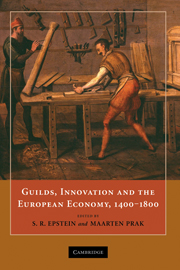Book contents
- Frontmatter
- Contents
- List of Contributors
- Acknowledgments
- Introduction: Guilds, Innovation, and the European Economy, 1400–1800
- 1 Craft Guilds, the Theory of the Firm, and Early Modern Proto-industry
- 2 Craft Guilds, Apprenticeship, and Technological Change in Pre-industrial Europe
- 3 Subcontracting in Guild-based Export Trades, Thirteenth–Eighteenth Centuries
- 4 Circulation of Skilled Labour in Late Medieval and Early Modern Central Europe
- 5 Painters, Guilds, and the Art Market during the Dutch Golden Age
- 6 Craft Guilds and Technological Change: The Engine Loom in the European Silk Ribbon Industry in the Seventeenth and Eighteenth Centuries
- 7 Guilds, Technology, and Economic Change in Early Modern Venice
- 8 Inventing in a World of Guilds: Silk Fabrics in Eighteenth-century Lyon
- 9 ‘Not to Hurt of Trade’: Guilds and Innovation in Horology and Precision Instrument Making
- 10 Reaching beyond the City Wall: London Guilds and National Regulation, 1500–1700
- 11 Guilds in Decline? London Livery Companies and the Rise of a Liberal Economy, 1600–1800
- Index
1 - Craft Guilds, the Theory of the Firm, and Early Modern Proto-industry
Published online by Cambridge University Press: 24 June 2009
- Frontmatter
- Contents
- List of Contributors
- Acknowledgments
- Introduction: Guilds, Innovation, and the European Economy, 1400–1800
- 1 Craft Guilds, the Theory of the Firm, and Early Modern Proto-industry
- 2 Craft Guilds, Apprenticeship, and Technological Change in Pre-industrial Europe
- 3 Subcontracting in Guild-based Export Trades, Thirteenth–Eighteenth Centuries
- 4 Circulation of Skilled Labour in Late Medieval and Early Modern Central Europe
- 5 Painters, Guilds, and the Art Market during the Dutch Golden Age
- 6 Craft Guilds and Technological Change: The Engine Loom in the European Silk Ribbon Industry in the Seventeenth and Eighteenth Centuries
- 7 Guilds, Technology, and Economic Change in Early Modern Venice
- 8 Inventing in a World of Guilds: Silk Fabrics in Eighteenth-century Lyon
- 9 ‘Not to Hurt of Trade’: Guilds and Innovation in Horology and Precision Instrument Making
- 10 Reaching beyond the City Wall: London Guilds and National Regulation, 1500–1700
- 11 Guilds in Decline? London Livery Companies and the Rise of a Liberal Economy, 1600–1800
- Index
Summary
As economic institutions, craft guilds have been judged unfavourably at least from the late eighteenth century onwards. In the view of the enlightened elites pressing for liberal reforms, craft guilds presented an obstacle to economic growth and welfare. In the course of the nineteenth century, both liberal and radical economists considered craft guilds as a paradigmatic institution of a pre-capitalist economy, while writers of the German historical school, such as Werner Sombart, viewed craft guilds as a materialisation of a typical pre-modern economic spirit. Prominent among the arguments put forward by eighteenth-century philosophes and nineteenth-century economists figures the supposition that craft guilds served mainly as cartels for the appropriation of monopoly rents for its members. At the same time, craft guilds are said to have resisted the transition from simple commodity production to more complex production regimes, which increased the control of entrepreneurs over production and enhanced productivity by applying new technology.
Recent scholarship has begun to re-evaluate the economic effects of late medieval and early modern craft guilds. First, it has been argued that craft guilds prevented market failure (adverse selection) in long-distance trade. Bales of textiles, in particular, were characterised by considerable asymmetry of information, in the sense that a buyer would have had to assess quality by unrolling and inspecting each bale, which would require a lot of time. Since long-distance merchants, local retailers, and consumers might all need to assess quality individually, information costs were unavoidably inflated.
- Type
- Chapter
- Information
- Guilds, Innovation and the European Economy, 1400–1800 , pp. 25 - 51Publisher: Cambridge University PressPrint publication year: 2008
- 12
- Cited by



